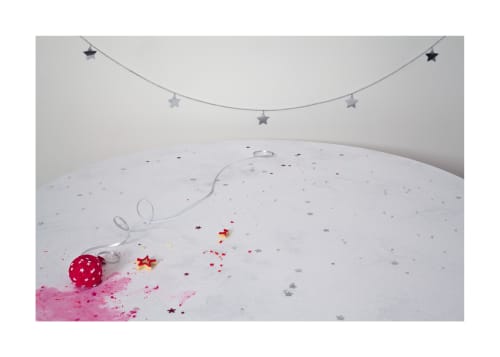MacDonald’s work traverses the vanitas still life genre; extending historical approaches by exploring the symbolic potential of objects within a contemporary cultural context. The photographic still life builds on the long history of vanitas imagery in art, and also brings with it the new association of the photograph as memento mori. Photography has a unique connection with still life and death, due to its ability to arrest time and literally still life. Photographs also contain a realisation of loss by recording a past moment that no longer exists. MacDonald draws on these associations to create elegiac metaphors for the ephemerality and mutability of existence.
The cemetery affords a rich source of imagery for MacDonald’s investigation into the themes of entropy and decay. For her installation Ornament 2008, she photographed Victorian floral grave decorations. In Ornament MacDonald considers how funerary ornaments are like photographs, in that they still life, yet eventually fall prey to time and slowly disintegrate, becoming premonitions of death rather than evocations of eternal life.
MacDonald’s interest in floral ornamentation is related to a long-term fascination with funerary bouquets and wreaths. In Petal 2000, she photographed blooming and withering flowers and isolated petals; capturing the fragile evanescence of flowers as a poignant symbol of mortality.
While photographing petals, MacDonald saw visual links to cloth as well as flesh. Her petals reference the funerary bouquet as well as the funeral shroud, and ultimately the corpse. This led to the creation of Annunciation 1994–5, Cloth 2004 and Silk 2005–6, in which opulent silks and brocades are stitched, torn, crumpled, stained and tattered; subject to the same vagaries of corporeal existence as the body.
The experience of motherhood shifted MacDonald’s visual language from traditional still life tropes to artefacts drawn from childhood. Unlike the slowly evolving adult, children change rapidly, almost daily. For MacDonald, the brevity and unrepeatability of youth is a powerful memento mori.
In Party 2013, MacDonald investigated children’s birthday parties as symbols of loss and impermanence. Children’s parties are vital social rituals, and on the surface of things, joyous and festive celebrations of life. However, on another level, they are melancholic indicators of time’s inexorable passing. In Party, MacDonald concentrates on the aftermath of the child’s birthday banquet, where the tumultuous chaos and exuberance of the day is replaced by the dull realisation that another passing birthday is over and yet another year of childhood gone.
Children’s birthday parties focus heavily on sugar-laden treats. This led to MacDonald’s 2016 project Sugar, where she continued her exploration of childhood, consumption and mortality. Sugar first appeared as a symbol of luxury in 16C desert and confectionary still life paintings. No longer a luxury, sugar is ubiquitous in food and is addictive, with the toxic effects of high sugar consumption recently gaining widespread media attention. It is an irony that we celebrate each birthday with sugary cakes and treats that potentially hasten life’s passing. Sugar highlights the excessive amount of sugar in children’s diets today, which, despite its adverse health effects, is still promoted as a reward or celebratory treat.
During her investigation of childhood and material culture, MacDonald became interested in the way in which gender is constructed and encoded during childhood. In Pink 2011, MacDonald examined the abundance of the colour pink within the consumer culture of girl’s toys. Created as accessories to children’s fantasies and imaginative play, the role of children’s toys extends beyond mere ornament and artifice to become powerful accoutrements to the transitory and impressionable childhood world. Chosen for their allusions to girlishness, cuteness and sweetness, MacDonald’s photographs of pink toys raise questions about monochromatic, one-dimensional and typecast representations of women. MacDonald returned to her investigation of gender colour coding in her most recent work Pink & Blue 2018; questioning why we attribute gender-specific colours to baby products. Is this practice merely to increase consumption or does it also reflect a simplistic and arbitrary pink-blue world view of femininity and masculinity?
